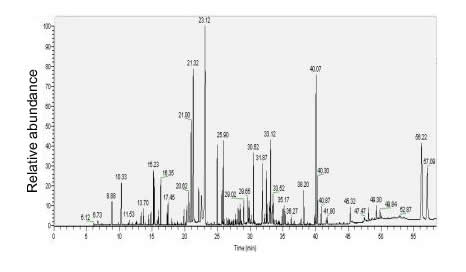Application of gas chromatography and mass spectrometry
Source from www.cubic.uni-koeln.de/.../metabolom.html
An approach to identify gene function in a particular strain of bacteria was to shut down individual genes and then analyse the levels of compounds in the cytoplasm. Gas chromatography coupled with mass spectrometry was used. Cells were broken apart and the metabolite mixture collected for separation and identification of the component compounds.
The animation on the right shows the technique of gas chromatography.
The mixture of metabolites is vaporised and pumped into the GC-column
where separation of the mixture takes place. Compounds with high affinity
to the stationary phase of the column are retarded in their movement through
the column by chemical interaction with the stationary phase. Components
with a low affinity to the stationary phase rush through the column (pushed
by the gas flow) and are eluted from the column first (items depicted
in green).

After separation of compounds by gas chromatography they are analysed by mass spectrometry. A typical chromatogram is shown on the right.
While passing through the mass spectrometer, molecules are ionised by electron impact with an energy of 70eV. Ionisation with this energy leads to a typical fragmentation of the molecule. Thus, each component of the bacterial cell extract can be identified according to its retention time (gas chromatography) and its mass spectrum. An in house data base was built containing information about metabolites that are supposed to be found in the bacterium.

Each compound has its typical mass spectrum. Mass spectra of alanine and glycine, below, are shown. A compound is identified by making use of its retention time and mass spectrum.
By comparison of the relative peak areas of two samples changes in metabolism are visualised. By a detailed analysis of the behaviour of the metabolic process within different pools of bacteria, information can be gathered as to the adaptation of the bacterial metabolism due to different growth conditions.


Term
|
Definition |
| Eluent. | |
| Desorption. | |
| Adsorption. | |
| Retention time. |
What determines the retention time of a compound? Solution
How can a substance be identified using gas chromatography?
Why is a mass spectrometer used?
What is the significance of the area under the peaks of a mass spectrum?
What happens to the sample in a mass spectrometer?
Could the researchers, in the project described above, have undertaken this research using just gas chromatography? Explain.
From your knowledge of gas chromatography could the researcher have used the same technique to identify large proteins of molecular mass in excess of 3000? Explain.
What technique could the researchers use to analyse large protein structures? Hint
Hide hint
Think of HPLC.